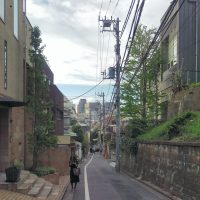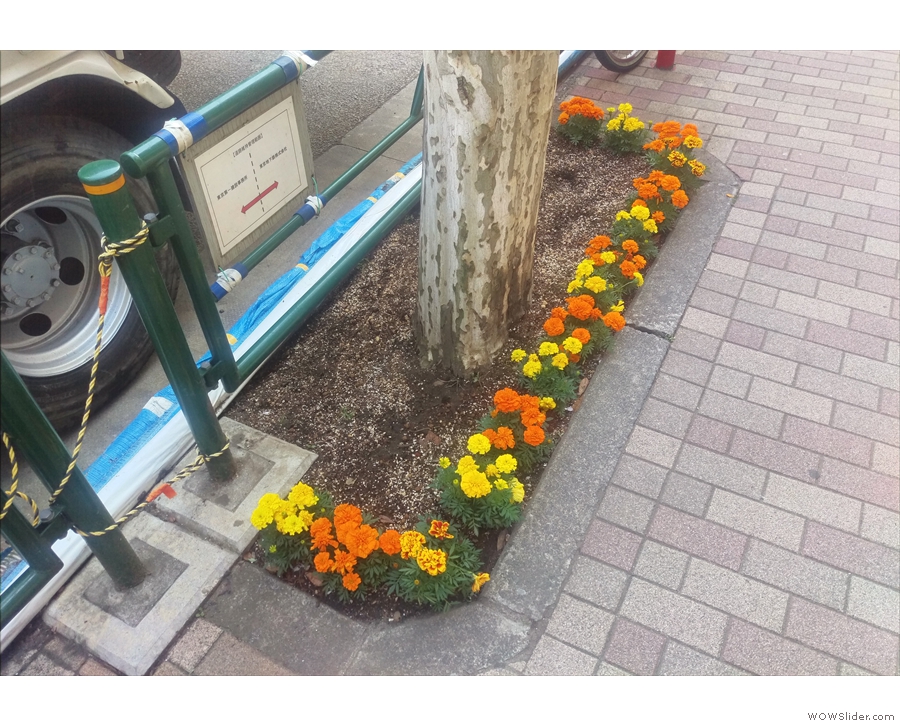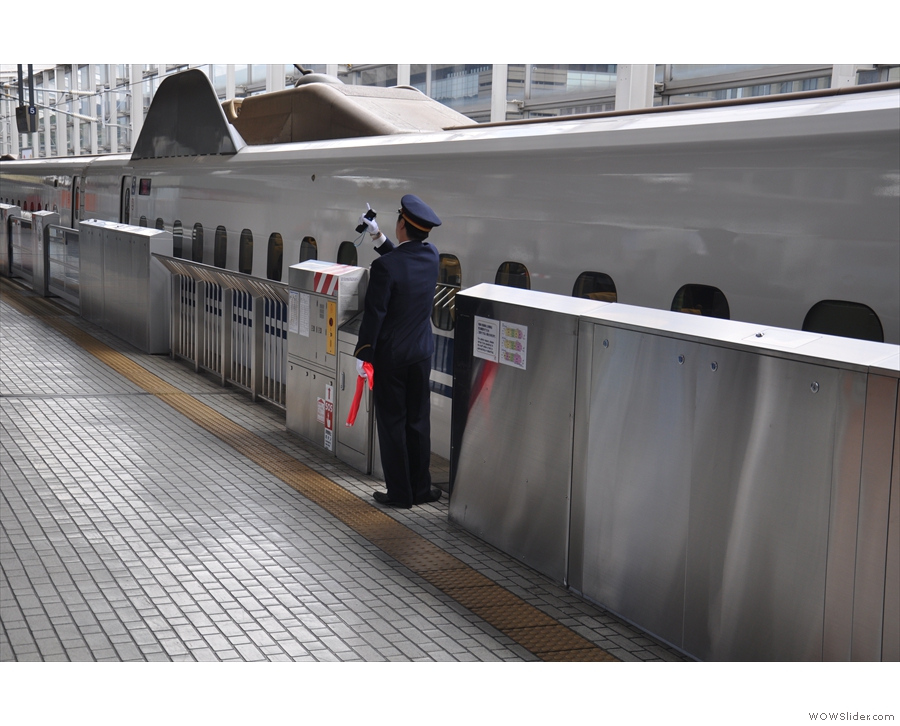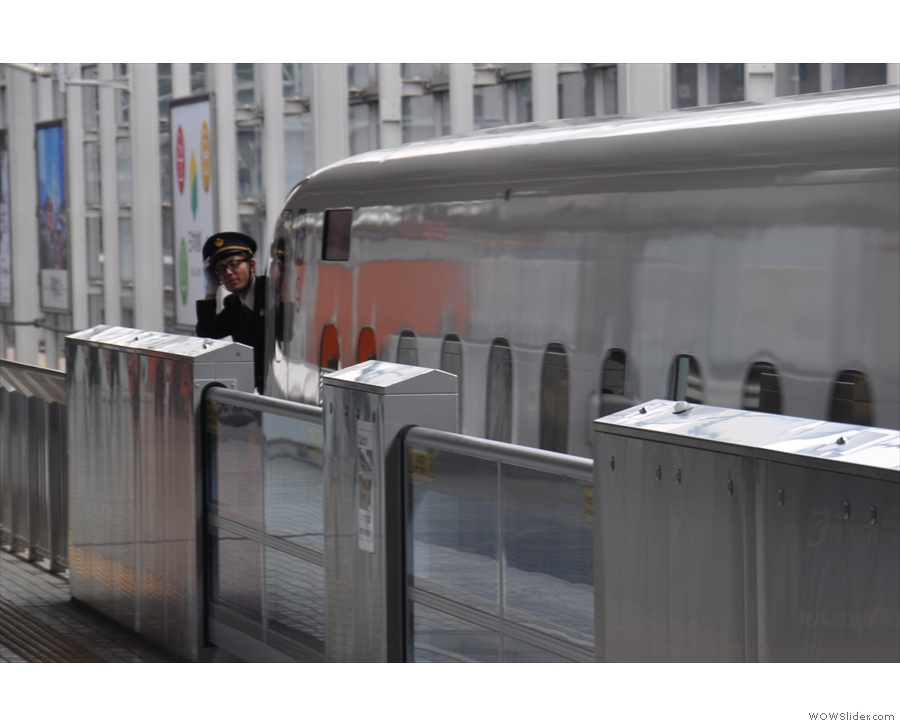 It’s almost been two weeks since I set off from Heathrow to fly, for first the time, to Japan. You can read about my (lack of) preparation for the trip and my thoughts about it in the previous Travel Spot. Rather than give a blow-by-blow account of my trip, including where I went and what I did, I’m taking a different approach with this Travel Spot, concentrating on my general impressions of Tokyo and, in another post, Japan (at least, those bits that I visited).
It’s almost been two weeks since I set off from Heathrow to fly, for first the time, to Japan. You can read about my (lack of) preparation for the trip and my thoughts about it in the previous Travel Spot. Rather than give a blow-by-blow account of my trip, including where I went and what I did, I’m taking a different approach with this Travel Spot, concentrating on my general impressions of Tokyo and, in another post, Japan (at least, those bits that I visited).
My trip’s been split into three parts. Part I involved three nights in Tokyo where I was pretty much getting over my jet-lag and gentling exploring random parts of the city. Part II was work, a Monday to Friday meeting that was ostensibly the purpose of the trip and involved moving to a swanky hotel in Shibuya (think Piccadilly Circus/Oxford Street or Times Square). Part III, the bit I’m on now, sees me exploring Japan by train for a week and will be covered in another Travel Spot.
Back to this Travel Spot, where I will kick off with some general observations about Tokyo, before moving on to talk about coffee shops and other matters.
You can read more of my thoughts after the gallery, except, of course, there is no gallery since I still don’t have my laptop… Rumour has it that it will be repaired tomorrow.
[Imagine all the pretty pictures]
I’ve been in Tokyo for almost two weeks, but to say I’ve “done” Tokyo would be absurd. I could spend a life-time in Tokyo and not “do” it and two weeks, particularly when a week of that was spent working. So, what follows are personal observations and are in no way definitive and, perhaps, not even representative. However, they are the things that struck me most about this amazing city.
First a little context to me trip. I arrived on Thursday, starting off staying in the Nishi Aazbu area for Part I, a relative non-descript area just southwest of Roppongi Hills (the area doesn’t even merit an entry in my guide book!). Chosen at random, it turned out to be an inspired choice, both in general and for coffee. The wonderful Maruyama Coffee was across the street from my hotel (one of the APA chain), while the lovely Nem Coffee was a ten-minute walk down the road. As a gentle introduction to Tokyo, I couldn’t have asked for better.
After three nights of relative calm, I moved to my new hotel, Cerulean Tower, for work. This involved two tube rides and a stop at Onibus Coffee in Nakameguro before negotiating the urban hell that is Shibuya. What can I say about Shibuya other than I hated it? Far too many people, far too much noise and, to be honest, I’m not sure why. As far as I can see, other than Shibuya station, which is a major transport hub, the only reason people come to Shibuya is to see the hordes of people at Shibuya. Who are only there to see the hordes of people… It all seems rather self-defeating…
However, regardless of the setting, there was good coffee to be had in the neighbourhood, including About Life Coffee Roasters and the old-school Cahtei Hatou. Plus the view from my room on the 22nd floor was pretty spectacular (although nothing compared to the view from the bar on the 40th floor). And it got me to a part of Tokyo I normally wouldn’t touch with a barge-pole!
From there I walked every day to the office where I was working. I could have taken the metro for two stops but it didn’t seem worth the hassle. Besides, I need the steps to keep my count up: yes, I have fallen prey to the Fitbit plague. I did 20,000 steps yesterday and when I synced with my Fitbit application, it almost exploded with excitement. It keeps me active I guess.
Regardless of the steps, the walk, 25-minutes of negotiating crowded walkways and busy roads, gave me a chance to see more of the city as well as get some excellent coffee along the way. The Local Coffee Stand was almost halfway between the hotel and the office, which is in Omotesando, and made a good spot to pick up a morning cappuccino (the flat white has yet to make it to Japan) while Coutume, Café Kitsune, Blue Bottle and Sarutahiko are all within a five minute walk of the office itself, so I never went short of good coffee (the office coffee was from Starbucks…).
After the luxury of the Cerulean Tower, I moved, on Saturday, to the Flexstay Inn in Shinagawa. This has the dual advantages of being cheap (eight nights for the price of two at the Cerulean Tower) and being a 10-minute walk from Shinagawa Station, my jumping-off point for Part III of the trip. An added advantage is that the Wi-fi there is waaaay better than the Cerulean Tower Wi-fi and an unexpected bonus was the discovered of the lovely Kaido Books & Coffee which is just down the street.
You can check out some of my impressions of Tokyo after the non-existent gallery.
Contrasts
Tokyo is a city of contrasts. In some respects, all cities are. Take London, for example. Step off Oxford Street and, within a block you’re in the relative quiet of Fitzrovia to the north or in the maze of Soho streets to the south. Or in New York City, where there are pockets of quiet such as Greenwich Village. However, all of these are relative and, while they are different, the areas are not that much different.
In Tokyo, however, the contrasts are far more immediate and much more striking. Away from the multi-lane highways, crosswalks and fly-overs, you don’t have to go far before you are in a completely different urban landscape, one of narrow roads, low-rise residential buildings and almost no people. I’ve never known a city like it.
Take the urban hell of Shibuya as an example. A five-minute walk north-east of the station and you are in residential streets. Go for ten minutes and you are in a maze of them, so narrow you can just about get a car down there. Not that there are many cars. Certainly no-one uses them for rat runs. And there are hardly any people either. And because the streets are so narrow, even when lined by three or four storey buildings, they effectively block out any distant horizons, so you can’t see the rest of the city towering around you. It really is very tranquil and such a contrast. Then you walk a block or two and you’re back on a multi-lane highway, complete with traffic and hordes of scurrying pedestrians.
These contrasts weren’t just at Shibuya. They were everywhere I visited, except, perhaps Ginza, the huge, built-up area just east of the Imperial Palace. Even there, though, the side streets were much quieter than the main thoroughfares. Around the office where I worked, just one block removed from the main, six lane highway, was a narrow street, part of a busy, but relaxed network of shops, cafés and restaurants that stretched for blocks (and contained the likes of Café Kitsune, Blue Bottle and Sarutahiko). Even in the relatively relaxed Nishi Azabu, where I started my trip, the next block over from the main road, which was lined with multi-storey tower blocks, the streets were narrow and low-rise.
I could go on, but I think you get the picture. My advice, for what it’s worth, is this. When you’re exploring, or even when you’re going from A to B, get off the main streets and take to the back roads. You might get turned around every now and then and take a little longer than you anticipated, but you’ll see a completely different Tokyo in the process.
Talking of different things, after the gallery [full gallery to come in due course] I’ll tell you about one of the first things to strike me about Tokyo that marked it out from other cities I’ve visited.
Soon after arriving in Tokyo, something that struck me. Despite how urban the city is, on a micro-scale, it’s very green. Although there are some large, open spaces of the sort that punctuate all large cities, these are few and far between in Tokyo. Perhaps to make up for that, many of the streets are tree-lined and almost everywhere you go, there are small, concrete flower boxes, planted with blooming flowers. Elsewhere, there are larger swathes of green, with roadsides being planted with walls of flowering bushes.
I suppose this fits with my earlier observations about Tokyo being a city of contrasts; just as you don’t have to go far from even the densest urban areas to find a quiet lane, so you are never far from a roadside flower box. In fact, one of my first impressions of Tokyo was stepping out of the Hiro-O metro station after arriving from the airport to see a small group of flowers planted around the base of a tree on the main road outside the station entrance. Looking to the left and right, I could see that this was repeated up and down the street. It made a good first impression; so good, in fact, that it was the subject of the first photograph I took in Tokyo.
Since then I’ve noticed flowers and greenery wherever I go. In the madness of Shibuya, there are concrete flower pots planted with flowers. In the large, modern developments, there are trees lining the streets and long lines of green, hedge-like shrubs. And, of course, there are the occasional, beautifully laid out gardens.
This isn’t just in Tokyo, by the way. I’ve noticed it, perhaps to a lesser extent, in Kyoto (which, in comparison to Tokyo, is a much greener city) and Osaka (which is less green, but still has pockets). I use green here to describe the amount of plant-life, not the overall environmental impact of each city!
None of this is accidental, of course. These plants haven’t just grown by themselves and looking after them must take considerable effort. This brings me to another observation, which you can read about after the gallery.
Tokyo (and Japan in general; the following observations apply to everywhere I went on the trip) seems to be a very personnel-intensive city. Coming from a western society with an emphasis on (obsession with?) “efficiency”, where the human element is stripped back as far as possible in the name of cost-cutting, it is surprising to see just how many people there are in Tokyo doing jobs that disappeared a generation or two ago in the UK (if they ever existed in the first place).
Car parks are a great example of this. At almost every car park entrance, there are one, usually two, uniformed employees with high-visibility jackets, hard hats and glowing light-sticks. Their job? To direct cars into the car park (not to a parking spot, they just direct them from the street into the car park) and to stop cars when pedestrians are walking across the entrance. This also happens at quite a few road crossings and you’ll see the same uniformed people at construction sites, waving trucks in and out and stopping them for passing pedestrians. Think of them as lollipop people for grown-ups.
To my eyes, it’s very strange and, ironically, unnecessary. Japanese drivers are perhaps the most conscientious I’ve ever seen. They don’t jump red lights and they always seem to give way. Pedestrians, meanwhile, are similarly disciplined. They too never cross the road except at designated crossings, nor do they walk when the pedestrian light is red, waiting patiently for it to turn green, even if the road is completely devoid of traffic.
Another example is the railways. My second week in Japan was spent travelling around using a rail pass. This doesn’t work with the automatic barriers, so I have to show it at the manual gates to enter and exit the station. If this had been the UK, it would have been a recipe for disaster, trying to find the one manned gate, with a queue of people going in either direction and one grumpy member of staff trying to deal with it all.
So, I was fearful this might cause me problems, but I should have known better. Almost every gate is manned, usually by a cheerful, polite, smiling member of staff (and the signs at the stations, in English as well as Japanese, clearly tell if which gates are manned/unmanned). This is particularly true at the large, inter-city stations on the Shinkansen lines, but I’ve found it to be more or less the case even at peak times in the busy, urban stations.
This extends to the platforms/trains where there are staff everywhere. There’s one member of staff on the platform and another two on the train itself, clearing it to leave. There are ticket inspectors on the trains too, making regular checks and walking up and down the train. Most of this has gone in the UK, swept away by “efficiency” and “cost cutting”.
As I hurtled around Japan, I did spare a thought for my friends back in the UK who are reliant on Southern Rail, where there’s been a long-running dispute about an attempt to move to driver-only operation (basically, the driver, ad driver alone, has the responsibility for ensuring that the train is safe to leave the platform). This has led to a series of strikes that show no sign of coming to an end as the rail unions fight the proposed changes. I suspect that the Japanese railways would be firmly on the side of the unions!
I find this all rather strange, particularly when Japanese manufacturing is, in my mind at least, synonymous with efficiency/automation and yet everyday society seems to have such an emphasis on people. Then again, as I have noted before, Japan is a country of contrasts.
I’ll return to the theme of a dense, urban city in the next instalment of this post.
If you liked this post, please let me know by clicking the “Like” button. If you have a WordPress account and you don’t mind everyone knowing that you liked this post, you can use the “Like this” button right at the bottom instead. [bawlu_buttons]
Don’t forget that you can share this post with your friends using buttons below.


 1
1

 1
1 2
2
Nice summary Brian. Reading this brings back good memories of my previous trips to Tokyo/Japan and makes me immediately envious! The one word in your entire post sums the city up for me ‘contrast’. The differences in busy/quiet, old/new, polite/rude are hard to grasp until you’ve been. Unlike yourself I rather liked Shibuya. In fact after staying in the same Cerulean Tower as yourself on two work trips, I still chose Shibuya as an area to stay when I came back on holiday. I think it’s just very well positioned as a base to get to many other areas of interest in the city. (Did you manage to get to Yoyogi Park. Would have been great at just the end of the Cherry Blossom.) Unfortunately I wasn’t as much of a coffee drinker when I was there, so can’t comment on the coffee shops, but this is just a small excuse to convince myself I need to go back!
I can actually see the attraction of Shibuya, despite being rude about it 🙂 However, it was a bit overwhelming for me. It is, though, as you say, a great transport hub and well connected.
I wish I had known you were there – would have sent you to some of my favourite spots 🙂
Sounds like you were around where I used to work a lot.
I was more Akasaka and Roppongi; Omedetosando is a great place (loop Meiji Shrine/Harajuku)….
Much of the joy of Japan is in finding restaurants that do one thing exquisitely well, and have been doing so for decades! That takes recommendations or guides. I now have some for coffee. The question though is getting a place that does equally good patisserie with them!
…when in Tokyo can I recommend Bear Pond Espresso! Tops coffee!
Top coffee, but a terrible attitude from the management.
Pingback: Japanese Coffee Cupping | Brian's Coffee Spot
Pingback: Sarutahiko Coffee Omotesandō | Brian's Coffee Spot
Pingback: Brian’s Travel Spot: Japan | Brian's Coffee Spot
Pingback: Brian’s Travel Spot: Returning from Tokyo in Club World | Brian's Coffee Spot